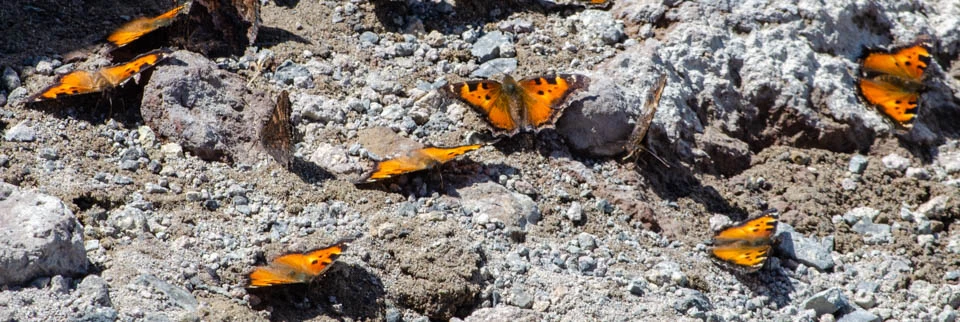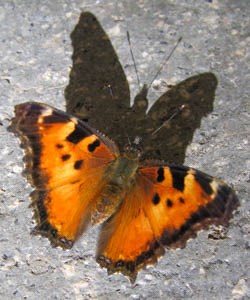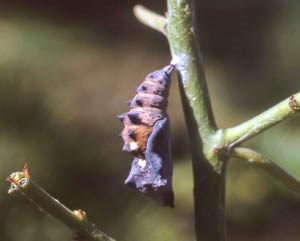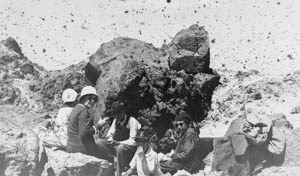Last updated: July 19, 2024
Article
California Tortoiseshell


California Tortoiseshell (Nymphalis californica) is a common sight at Lassen Volcanic National Park in the summer months, although the number of individuals varies widely from year to year. Occasionally mistaken for the monarch (Danaus plexippus), this mass migrant tends to travel shorter distances between foothill canyons and high elevation locations in the Sierrra Nevada and sometimes even the Cascade mountain ranges.
Summer 2024: California Tortoiseshells have been sighted in the park in large numbers. The last population explosion or mass migration was in 2019. The second brood of new adults emerged in mid July, and will be present for a few weeks throughout the park. Tortoiseshells are seen in high numbers on tops of peaks such as Lassen Peak while estivating.
Identification
The Tortoiseshell is part of the Brush-footed family (so-called because their fore-legs resemble hairy stumps). To identify a California Tortoiseshell, look for bright orange-brown wings, dark markings, and a two-inch wingspan. When the Tortoiseshell is perched, it may be more difficult to distinguish as its wing undersides are a mottled brown, allowing the butterfly to seamlessly camouflage with tree trunks.

One Brood in Spring, Another in Summer
First Brood Emerges in the Foothills
California Tortoishells are generally common in the foothill canyons in late winter where they emerge from hibernation to lay eggs on the young, tender growth of various species of wild lilac (Ceanothus). The spiny, black-marked-with-yellow larvae feed noisily and a large population can defoliate the plants over wide areas. They often pupate (or form a chrysalis) on the bare, leafless stems in large masses. Adults of the first brood emerge in late May or early June and begin moving to higher elevations in search of food.
Second Brood Emerges during Migration
Summer breeding takes place in early migration when migrant females lay eggs on new buds of the high-altitude Ceanothus such as tobaccobrush and snowbrush. Occasionally the upslope movement encounters the retreating snowline, forcing females to lay only on Ceanothus that have melted out. This can result in enormous larval densities, total defoliation of the hosts and mass starvation.[1] The adults of the second brood layed during migration, emerge in July. This second brood is highly concentrated, however the locations vary from to year to year and often include the high country of Yosemite, Sequoia and Kings Canyon, and Lassen Volcanic national parks; and even the Trinity Alps and south Cascades. Many years, these large populations of second-brood butterflies appear within the park (see Clouds of Butterflies below) and can be seen crowding into a single puddle and visiting flowers including coyote mint (mondardella).
Estivates on Mountaintops
The arrival of the hot, dry summer months prompt the Tortiseshells to estivate, or enter a state of inactivity in which the butterflies live off of the fat accumulated during their caterpillar phase. In high population years, large numbers of Tortoiseshells can be found "hanging out" on the slopes and summit of Lassen Peak estivating and providing an easy meal for hungry birds.
Scatters Downslope for the Winter
In late September the butterflies migrate downslope to the foothills, in search of hibernation sites. In late winter, the butterflies awake from hibernation and the cycle begins once again.

Norman Scherer, Lassen Volcanic National Park Photograph Archives C5.6.42B.
Clouds of Butterflies
Along with the Painted Lady (Vanessa cardui), which is also commonly sighted in Lassen Volcanic, California Tortoiseshell has regular population explosions and mass migrations. In late July to early August 2004, a swarm of Tortoiseshells 40 to 50 miles long by 15 miles wide traveled south along the Sierra Nevadas.This swarm estivated (inactivity of butterflies during warm summer months) in the Sierra Nevadas before scattering and returning in September to Sierra and Cascade foothills to hibernate for the winter[2].
Although the rhythm of seasonal migration is constant, the number of individuals vary dramatically and not in a predictable cycle. Some years, unsuspecting hikers are stunned by clouds of tortoiseshells in Lassen Volcanic and especially on Lassen Peak. Other years, the butterfly is no more prevalent than other species found within the park.
Keep it under 30 MPH
In the event you are lucky enough to witness a population explosion or mass migration, you can enjoy the sight and protect the butterflies by traveling under 30 mph. A slower speed allows the butterflies to drift over your vehicle instead of decorating your vehicle's grill or adding a large, yellow splat to your windshield.
[1] Shapiro, Art, Nymphalis californica. http://butterfly.ucdavis.edu/butterfly/Nymphalis/californica.
[2] Shapiro, A.M, and Manolis, T.D. (2007). Field Guide to Butterflies of the San Francisco Bay and Sacramento Valley Regions. Oakland, California: University of California Pr. page 189
